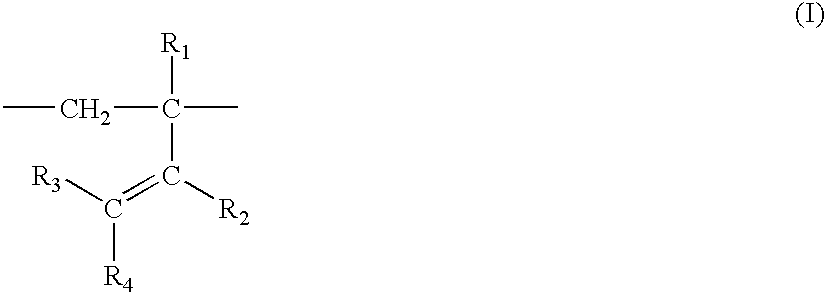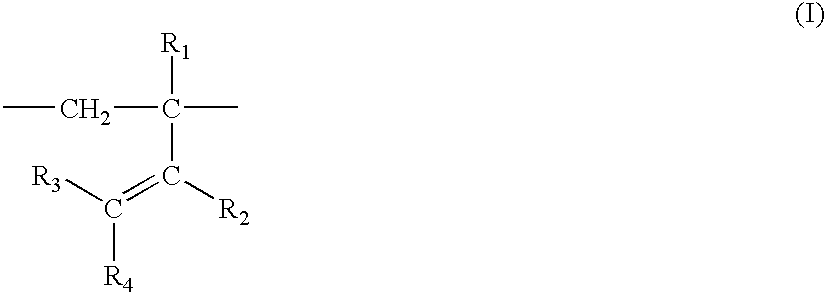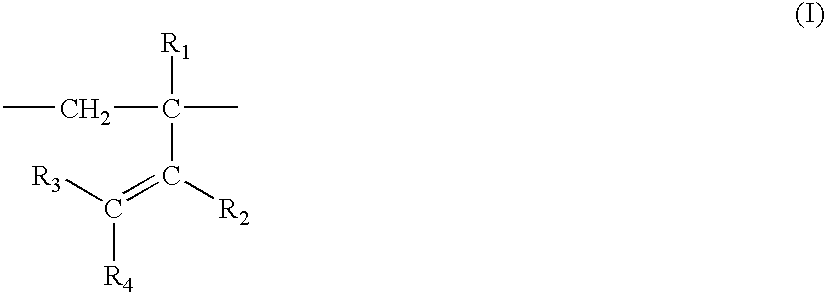Resin composition and a multilayered container
a multi-layered container and resin technology, applied in the direction of synthetic resin layered products, packaging, conductive materials, etc., can solve the problems of oxid degradation of food contents, and failure to provide sufficient oxygen barrier properties, etc., to achieve good impact delamination resistance, good gas barrier properties, good aroma retentivity and flavor barrier properties
- Summary
- Abstract
- Description
- Claims
- Application Information
AI Technical Summary
Benefits of technology
Problems solved by technology
Method used
Image
Examples
example 1
First, 71.4 parts by weight of the triblock copolymer (B-1), 28.6 parts by weight of the compatibilizer (C-1) and 3.0300 parts by weight of cobalt (II) stearate (0.2857 parts by weight in terms of cobalt atoms) were dry-blended. The blend was extruded into pellets with a 30 mm .phi. twin screw extruder (TEX-30.degree. S.S-30 CRW-2V, manufactured by Japan Steel Works, Ltd.) at 200.degree. C., a screw rotational speed of 300 rpm, and an extruded resin amount of 25 kg / hour, while purging the cylinder with nitrogen. These pellets were dried at 30.degree. C. under reduced pressure for 8 hours to give resin composition pellets comprising the triblock copolymer (B-1), the compatibilizer (C-1) and cobalt stearate.
The obtained resin composition pellets were extrusion-molded at an extrusion temperature of 210.degree. C. into a film having a thickness of 20 .mu.m (a first single layer film). The haze value of the film was 1.8%. Then, 0.9 m.sup.2 (0.2 m.times.4.5 m; a surface area of 1.8 m.sup....
example 2
First, 71.4 parts by weight of the triblock copolymer (B-1) used in Example 1 and 28.6 parts by weight of the compatibilizer (C-1) were dry-blended. The blend was extruded into pellets at 200.degree. C. with a 30 mm .phi. twin screw extruder (TEX-30SS-30CRW-2V, manufactured by Japan Steel Works, Ltd.) at a screw rotational speed of 300 rpm and an extruded resin amount of 25 kg / hour while purging the cylinder with nitrogen. These pellets were dried at 30.degree. C. under reduced pressure for 8 hours to give resin composition pellets composed of the triblock copolymer (B-1) and the compatibilizer (C-1).
A film having a thickness of 20 .mu.m was obtained from this resin composition in the same manner as in Example 1. The haze value was measured and found to be 1.6%.
A resin composition was obtained in the same manner as in Example 1, using 74.4 parts by weight of the EVOH (A-11) used in Example 1, 18.6 parts by weight of the EVOH (A-21) shown in Table 2, 7 parts by weight of the resin co...
example 3
A resin composition was obtained in the same manner as in Example 2 except that the EVOH (A-12) shown in Table 2 was used instead of the EVOH (A-11). The melt flow rate (210.degree. C., 2160 g load) of this resin composition was 9.2 g / 10 min. Observation of the cutting plane of the resin composition pellets through an electron microscope confirmed that the triblock copolymer (B-1) was dispersed in the form of a particle having a size of about .sup.1 .mu.m or less in the matrix of the EVOH.
A film having a thickness of 20 .mu.m was obtained from this resin composition in the same manner as in Example 1. The haze value was measured and found to be 1.4%. When the oxygen absorption amount was measured, the results shown in FIG. 2 were obtained. The oxygen absorption rate of the film was 0.938 ml / m.sup.2 .multidot.day. Next a multilayered film was produced in the same manner as in Example 1. The haze value was measured and found to be 2.7%. When the oxygen transmission rate was measured o...
PUM
 Login to View More
Login to View More Abstract
Description
Claims
Application Information
 Login to View More
Login to View More - R&D
- Intellectual Property
- Life Sciences
- Materials
- Tech Scout
- Unparalleled Data Quality
- Higher Quality Content
- 60% Fewer Hallucinations
Browse by: Latest US Patents, China's latest patents, Technical Efficacy Thesaurus, Application Domain, Technology Topic, Popular Technical Reports.
© 2025 PatSnap. All rights reserved.Legal|Privacy policy|Modern Slavery Act Transparency Statement|Sitemap|About US| Contact US: help@patsnap.com



